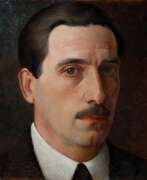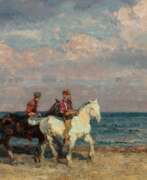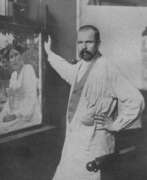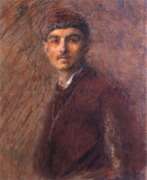Rural landscape Symbolism


Wilhelm Schmurr was a German painter and co-founder of the Sonderbund in Düsseldorf. His style, characterized by clear expression, was influenced by the Pre-Raphaelites, Symbolists, and Realists. He received several awards and medals for his work and was a member of various art associations. Schmurr taught at the Kunstakademie Düsseldorf and inspired by the farmers after the war, he created scenes of simple life and still lifes. He was awarded the Karl-Ernst-Osthaus-Preis and the Bundesverdienstkreuz erster Klasse and became an honorary member of various artist associations.


Louise Elisabeth Andrae was a German Post-Impressionist landscape painter and watercolorist. She studied with two landscape painters; Gustav Adolf Thamm in Dresden and Hans von Volkmann in Karlsruhe. She settled in Dresden, but spent long periods on the island of Hiddensee. There, she helped organize a group known as the Hiddensoer Künstlerinnenbund, an association of women artists that included Clara Arnheim, Elisabeth Büchsel, Käthe Loewenthal and Katharina Bamberg. They were regular exhibitors at an art venue known as the Blaue Scheune (Blue Barn), established in 1920 by Henni Lehmann. She also exhibited frequently with a group known as the Kunstkaten in Ahrenshoop.Wikipedia


Angelo Barabino was an Italian painter, divisionist-symbolist, exponent of the social current, friend and pupil of Giuseppe Pellizza da Volpedo.
In Barabino's work we encounter realistic and symbolic instances applied to not infrequently social-oriented themes, always supported by a technical quality that was reworked on Pellizza with wholly original results.


Eugen Felix Prosper Bracht was a German landscape painter.
A late Romanticist painter, Bracht was known for his moody landscapes and coastal scenes in North Germany, and began a sketching trip through Syria, Palestine and Egypt from 1880 to 1881. In 1882, he became a Professor of Landscape Painting at the Prussian Academy of Arts.
Later, Bracht became a representative of German Impressionism.
In 1901, he obtained a teaching position at the Dresden Academy of Fine Arts that he held until 1919.


Georg Janny was an Austrian landscape painter and set designer.
He worked as a scene painter in the studios of Carlo Brioschi and Johann Kautsky, alongside Alfons Mucha, and was a member of the Dürerbund.
He also painted landscapes and figures, including scenes from fairy-tales or imaginary worlds that are reminiscent of the works of Arnold Böcklin or Gustave Doré.


Henri-Jean Guillaume Martin was a French painter. Elected to the Académie des Beaux-Arts in 1917, he is known for his early 1920s work on the walls of the Salle de l'Assemblée générale, where the members of the Conseil d'État meet in the Palais-Royal in Paris. Other notable institutions that have featured his Post-Impressionist paintings in their halls through public procurement include the Élysée Palace, Sorbonne, Hôtel de Ville de Paris, Palais de Justice de Paris, as well as Capitole de Toulouse, although the Musée des Beaux-Arts de Bordeaux and Musée des Augustins also have sizeable public collections.


Constant Montald was a Belgian painter, muralist, sculptor, and teacher. In 1874, while receiving an education in decorative painting at the technical school of Ghent during the day, Montald also enrolled in the evening-classes of the Royal Academy of Fine Arts in Ghent. There he won in 1885 a competition and received a grant from the city which enabled him to live and study briefly in Paris at the École des Beaux-Arts. In Paris he painted his first monumental canvas, The Human Struggle. In 1886, Montald went on to win the Belgian Prix de Rome. He then went on a grand tour of Italy. He traveled extensively until he eventually settled in Florence, where he made preparations for a Grand work he eventually completed in Rome. This grand work, titled "Social Contradictions", was kept in the basement of the Royal Museum of Art and History of Brussels after it was displayed there in 1890 after being sent over from Rome. The First World War prevented Montald from painting Monumental works, instead he focused on painting on an easel. Montald co-founded the group L'art monumental. This group promoted a decorative monumental style connected to architecture.


Dagmar Riese is a German painter, graphic artist and sculptor. He studied sculpture, painting and restoration at the art school in Flensburg. He was also a private pupil of the Basel artist Barbara Linhart. Dagmar Riese currently lives and works in Hamburg, Germany.


Jeanne Selmersheim-Desgrange was a French Neo-Impressionist painter who used the art technique of pointillism in her paintings. She was a pupil of Paul Signac.
Jeanne Zelmersheim-Desgrange's art was influenced by Symbolism, a movement that sought to convey emotions, dreams and spiritual themes through visual images. She experimented with bright colours and bold brushstrokes, capturing the essence of her subjects and conveying a sense of energy and emotion.


Oskar Bruno Zwintscher was a German painter. He is often associated with the Jugendstil movement. From 1887 to 1890 he studied at the Hochschule für Grafik und Buchkunst Leipzig and, from 1890 to 1892 was a student at the Dresden Academy of Fine Arts. After his studies, he became a free-lance painter in Meißen, where he received a stipendium, awarded to Saxon painters by the "Munkeltsche Legat". In 1898, he presented his first large collection of paintings to the public. That same year, he was a prizewinner at a contest held by the entrepreneur Ludwig Stollwerck to select artists for a new line of trading cards. His first series of cards, "Jahreszeiten" (The Seasons), was published later that year. This was followed in 1900 by "Das Gewitter" (The Tempest). From 1903, he served as a professor at the Dresden Academy. He was an unshakable opponent of impressionism. Despite this, and his involvement with advertising, much of his work is openly erotic or has an eerie quality. His style has been likened to a contemporary version of Holbein or Cranach, but also contains elements of Art Nouveau.





















